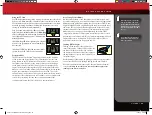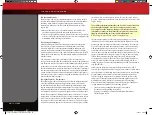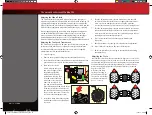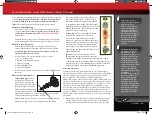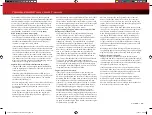
T-MAXX • 31
Adjusting the Camber
Two pivot balls are accessible through
the spokes of each of the wheels on your
T-Maxx. From the factory, the pivot balls are
completely tightened into the suspension
arms, which give each of the wheels –1˚ of
camber. Unscrewing the bottom camber
pivot ball with a 2.5mm hex wrench will
increase the wheel’s negative camber. You should not adjust the top
pivot ball; unscrewing it will increase positive camber and will also
change the wheel’s toe-in.
Fine Tuning the Shocks
The eight shocks (oil dampers) on your
T-Maxx have tremendous influence
on its handling. Whenever you rebuild
your shocks or make any changes to
the pistons, springs, or oil, always do it
carefully and in sets (front or rear). Piston
head selection depends on the range of
oil viscosities that you have available. For
example, using a two-hole piston with
lightweight oil will give you the same
damping as a three-hole piston with
heavier oil. We recommend using two-hole
pistons with a range of oil viscosities from
10W to 40W (available from your hobby
shop). The thinner viscosity oils (30W or
less) flow with less resistance and provide
less damping, while thicker oils provide
more dampening. Use only 100% pure silicone shock oil to prolong
seal life. From the factory, the T-Maxx uses 30W oil.
The ride height for the T-Maxx can be adjusted by adding or removing
the clip-on spring pre-load spacers. Note that changes in ride height
will occur when changes in shock angle or spring rates are made. You
can compensate for ride height changes by changing the pre-load
spacers on the shocks.
Adjusting the Suspension
The T-Maxx has adjustable suspension so that it may be optimized for
different kinds of terrain and driving styles.
Caster Adjustment
The T-Maxx offers the ability to adjust the caster angle of the front
suspension. Caster adjustment may be used to influence the understeer/
oversteer handling characteristics of the T-Maxx. Increasing the caster
angle will increase the tendency of the truck to oversteer (less traction
on the rear tires, more traction on the front tires), while decreasing the
caster angle will cause the truck to have a tendency to understeer (push
in the turns). This effect becomes more pronounced at higher steering
angles and higher spring rates. Caster is adjusted by repositioning the
shims on the pivot point of the upper suspension arms.
The stock caster setting is 7 degrees, with one shim at each end of the
arm. Reduce the caster angle to 4 degrees by removing the rear shim
and inserting it next to the front shim. The caster angle can be increased
to 10-degrees by removing the front shim and inserting it next to the
rear shim.
TUNING ADJUSTMENTS
Factory toe-in settings can
be achieved by installing the
rod ends on the turnbuckles
until they bottom out
against the shoulder. If you
desire more toe-out, the
tips of the rod ends must be
trimmed to allow them to
screw down further onto the
turnbuckle threads.
0°
0°
1°
1°
-1°
-1°
A camber gauge (available
at your local hobby shop)
can be a useful tool for
alignment setting.
49104-1-KC2230-R00-T-Maxx-Operating.indd 31
10/30/14 5:10 PM







